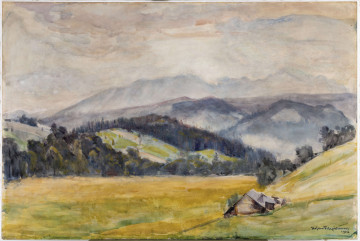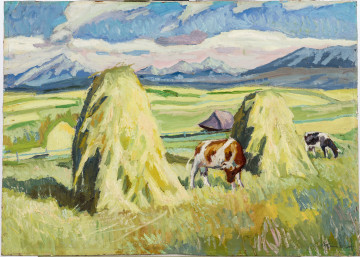
Mountainscape
1992 — 1922
National Museum in Lublin
Part of the collection: Polish landscape painting (19th–1st half of the 20th c.)
The work of Franciszek Rerutkiewicz (1885-1923) was in line with the characteristic trends of the era. Born in Stanislawow, he received his artistic education at the Academy of Fine Arts in Krakow in the studio of Joseph Pankiewicz. From the master he took interest in the landscape in the tradition shaped by Paul Cézanne's painting. Carefully framed views revealed subsequent areas of applied colour, combining a thorough observation of nature with a reflection on its painterly creation. At the same time, the small formats of the images of nature, brought out with a skilful, sweeping gesture, referred to the native tradition of Jan Stanisławski's landscapes. Rerutkiewicz's short works captured the antinomies characteristic of the first decade of the 20th century, defined by discipline and simplification of forms in accordance with the Cézanne tradition, as well as a search for drama and emotions originating in the expressionistically experienced landscape.
After his studies and stay in Paris, the artist returned to Poland and took part in the 1st Exhibition of Polish Expressionists, which was fundamental for the history of the Polish avant-garde, inaugurating the activity of the Formists. After this exhibition he settled in Zakopane, an artistic colony bringing together different personalities – Witkacy, August Zamoyski, and Leon Chwistek. His premature death interrupted his artistic search.
Pejzaż zakopiański [Zakopane Landscape] from 1918 is a clear testimony to following the path of the master Józef Pankiewicz and the careful landscape constructions of Cézanne. It is shaped by clear strokes of pure colour bands, marking the slanting, rhythmical geometry of ascending compositions of painting plans, reproducing earthy fields, green meadows, a part of the forest, and finally, in the distance, rocky cones of mountains framed by cool blue. For Rerutkiewicz, brushstrokes marked the construction of a painting, the search for colour harmony and, at the same time, the simplification of a landscape emerging in spatial relations – close-ups and distances – through varied handling of texture, the density of the painting matter and contrasting chromatics of light and dark fields and cool and warm colours.
Author / creator
Dimensions
cały obiekt: height: 22 cm, width: 19,5 cm
Object type
painting
Technique
oil technique
Material
cardboard, oil-based paint
Creation time / dating
Creation / finding place
Owner
The National Museum in Lublin
Identification number
Location / status

1992 — 1922
National Museum in Lublin

1901 — 1950
National Museum in Lublin

1936
National Museum in Lublin
DISCOVER this TOPIC
National Museum in Szczecin
DISCOVER this PATH
Educational path